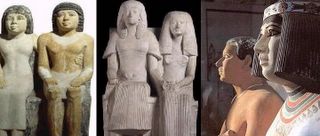
Recent archaeological discoveries have revealed that, contrary to popular belief, it was not John Logie Baird who invented television but the Ancient Egyptians.
The above image shows three couples waiting patiently for their turn to take part in Nefertiti TV's primetime blockbuster "Tut and Nut" gameshow (later to be renamed "Him and Her" - or Him and Them/Her and Them in the case of royal-household polygamous or polyandrous relationships).
The show format was simple but ingenious. One member of a couple appeared before a studio audience in the grand gallery and was asked questions about the nature of his or her spouse who, to prevent cheating, was meanwhile blindfolded and force-fed easy-listening music through headphones in an antechamber elsewhere in the pyramid. After the initial round of questions had been asked, the spouse was thereupon led into the grand gallery and asked to respond to the same questions that had been put to his or her wife or husband. Success was based on the similarity of the couple's answers and winning couples were those who had most assimilated the irritating, pernickety habits and neuroses of their partners into their own psyches.
With the decline of Egyptian culture, television also disappeared. It was not rediscovered until 16 February 1923, when Howard Carter opened the inner chamber of the tomb of Tutankhamun, only to find that the boy Pharoah had died while watching a 14th-century BC version of "Big Brother". John Logie Baird's London transmission of a static image of Felix the Cat in February 1924, only one year later, was by no means a coincidence.
The great Pharaohs are now believed to have been buried with their, slaves, pet animals and favourite gameshow hosts.
These discoveries have forced archaeologists and anthropologists to reappraise the long-held notion that Egyptian culture was advanced for its time.


2 Comments:
At 5:07 pm, Dave said…
Dave said…
It is a little-known fact that, but for the slip of a pen, the famous ‘Ally Pally’ (the Alexandra Palace in London), the main broadcasting centre for the BBC until 1956, would have been called the Alexandria Palace, after the original home of broadcasting in Egypt.
At 5:17 pm, Bob said…
Bob said…
.. the broadcasting antenna of which bears an uncanny resemblance to the obelisks at Karnak and Luxor.
Post a Comment
<< Home